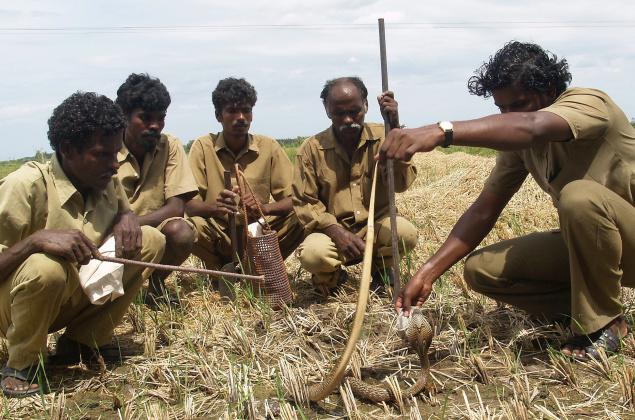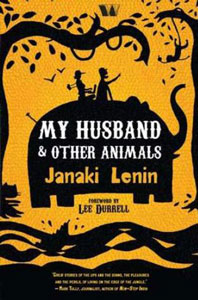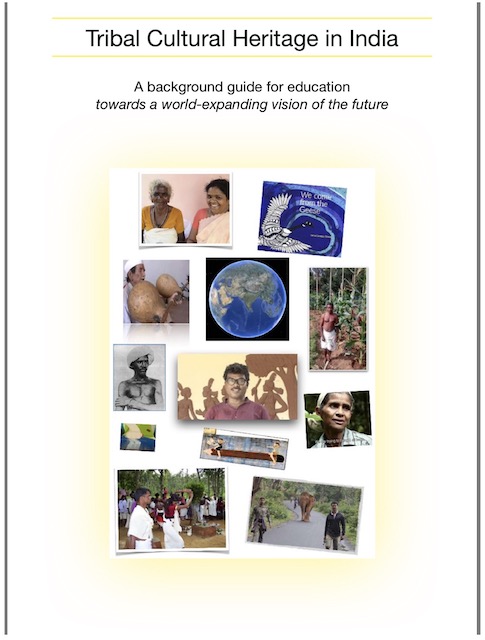“We are so much more than that. We follow a tradition rich in music, dance and love.” – Author Swarnalatha who runs an NGO that works for the upliftment for people of her Irula community >>
Janaki Lenin’s book [My Husband and Other Animals], a compilation of her popular column in The Hindu MetroPlus, offers insights into her husband Rom Whitaker’s fascination for animals, particularly snakes
When he came to Madras, Rom was introduced to the Irulas, who quickly became his buddies, sharing, as they did, a common love for snakes. […]
Commenting on the “polarised issue” of tribals eking out a living outside forests, Janaki said her perspective has been coloured watching the Irulas. “When they’re educated, they join the rat race. They come to the city slums and become electricians and plumbers, because we don’t encourage their skills.” How do we bring the benefits of modern society to the tribals and value their centuries-old life-skills, she asked.
The Irulas are perfect as guides, Janaki said, talking about the pressing need to help urban children connect with nature. “Irulas can conjure scorpions and chameleons out of thin air!” Besides, national parks have become “a tamasha,” she lamented, adding that, even in the crocodile bank, people chuck rubbish into enclosures expecting the cleaning service to be part of the entrance fee; “how do you engage with that attitude?” […]
Janaki gave more credit to the animals. People take credit for their smartness, she said, but they mostly get away only because animals practise restraint. […]
Source: Husband, animals, anecdotes… – The Hindu APARNA KARTHIKEYAN, The Hindu, 11 December 2012
Address : https://www.thehindu.com/features/metroplus/husband-animals-anecdotes/article3987811.ece
Date Visited: Fri May 10 2013 11:00:26 GMT+0200 (CEST)
Find scholarly books, poetry and fiction relating to tribal culture – Indian publishers
List of sites covered by this Google custom search engine
To find children’s and educational books or search Indian periodicals, magazines, web portals and other sources safely, click here >>
Search tips
Combine the name of any particular state, language or region with that of any tribal (Adivasi) community.
Add keywords of special interest (music, poetry, dance just as health, sacred grove and biodiversity); learn about the rights of Scheduled Tribes such as the “Forest Rights Act” (FRA); and the United Nations “Declaration on the Rights of Indigenous Peoples”, “Universal Declaration of Human Rights”, “women’s rights”, or “children’s right to education”.
Ask a question that includes “tribal” or “Adivasi”, for instance: “Adivasi way of life better?” (or “tribal way of life worse?”)
Specify any particular issue or news item (biodiversity, bonded labour and human trafficking, climate change, ecology, economic development, ethnobotany, ethnomedicine, global warming, hunter-gatherers in a particular region or state, prevention of rural poverty, water access).
For official figures include “scheduled tribe ST” along with a union state or region: e.g. “Chhattisgarh ST community”, “Himalayan tribe”, “Scheduled tribe Tamil Nadu census”, “ST Kerala census”, “Particularly Vulnerable Tribal Group Jharkhand”, “PVTG Rajasthan”, “Adivasi ST Kerala”, “Adibasi ST West Bengal” etc.
In case the Google Custom Search window is not displayed here try the following: (1) toggle between “Reader” and regular viewing; (2) in your browser’s Security settings select “Enable JavaScript” | More tips >>
Note: hyperlinks and quotes are meant for fact-checking and information purposes only | Disclaimer >>
Tribal languages are a treasure trove of knowledge about a region’s flora, fauna and medicinal plants
“Tribal languages are a treasure trove of knowledge about a region’s flora, fauna and medicinal plants. Usually, this information is passed from generation to generation. However, when a language declines, that knowledge system is completely gone.” – Ayesha Kidwai (Centre for Linguistics, School of Language, Literature and Culture Studies, Jawaharlal Nehru University, New Delhi) quoted by Abhijit Mohanty in “Seven decades after independence, many tribal languages in India face extinction threat” | Learn more about the work done by the People’s Linguistic Survey of India and endangered languages worldwide >>
“India’s geographic location at the confluence of three major biogeographic zones – i.e. the Indo-Malayan, the Eurasian and the Afro-Tropical – makes it extremely biodiverse in its genes, species and ecosystems. It is one of the world’s 17 megadiverse countries (Mittermeier et al. 1997). India can boast of over 8.1% of the world’s biodiversity supported on 2.4% of the earth’s surface. An estimated 47,000 identified plant species represent 11% of the world’s flora.” | Learn more: eBook | Disseminating environment related information to improve peoples’ livelihoods >>
“The notion of ‘mainstreaming’ needs to be challenged not just because Adivasi culture is being crushed, but also because Adivasi values and ways of life offer insights that the ‘mainstream’ needs. If we are to halt the destruction of ecosystems, we need to understand how closely biodiversity and cultural diversity are intertwined. Perhaps it is time to reverse the gaze and begin to learn afresh from Adivasis.” – Felix Padel & Malvika Gupta (The Hindu) | Learn more about the role of tribal communities in fostering biodiversity, ethnobotany and cultural diversity | Success stories | Tribal identity >>
“I think that by retaining one’s childhood love of such things as trees, fishes, butterflies and … toads, one makes a peaceful and decent future a little more probable, and that by preaching the doctrine that nothing is to be admired except steel and concrete, one merely makes it a little surer that human beings will have no outlet for their surplus energy except in hatred and leader worship.” – George Orwell | Learn more: Childhood | Customs | Games and leisure time | Literature – fiction | Storytelling >>

Photo credit: M. Karunakaran © The Hindu >>
Learn more about the Irula community & Snake >>
To a large extent, the primary actors in these stories are animals, from pet dogs to neighbourhood leopards! But just as important are human players in this depiction of life; farmers on adjacent lands, the Irulas, a snake-catching tribe from Southern India, and a bevy of the author’s friends and colleagues, some flabbergasted by her benign acceptance of ever-present wildlife. […]
Through Janaki Lenin’s eyes, we see the world come alive—the insects hovering are now dancing for their nectar, birds are vying for the attention of their suitors and frogs move.
Source: Bringing Animals Back into Our Backyard
Address : http://www.thebookreviewindia.org/articles/archives-1239/2013/april/4/bringing-animals-back-into-our-backyard.html
Date Visited: Fri May 10 2013 11:21:52 GMT+0200 (CEST)
Learn more
Atree.org | Ashoka Trust for Research in Ecology & the Environment (posts)
Biodiversity | Biodiversity hotspot | Hyderabad biodiversity pledge
Climate change | Audio | The Climate Question (BBC Podcast)
eBook | Background guide for education
Ecology and environment | Eco tourism | Tourism | Wildlife tourism
Environmental history and what makes for a civilization – Romila Thapar
Equations blog (Equitable Tourism Options)
Forest Rights Act (FRA) | Hunter-gatherers | Illegal mining | Legal rights over forest land
Information provided by Indian government agencies and other organizations (FAQ)
Nature and wildlife | Crocodile | Elephant | Tiger | Mangrove forest | Trees
PARI’s tales from tiger territory | People’s Archive of Rural India (PARI)
Shola Trust | Nilgiri Biosphere
Water and development – India’s tribal communities
Western Ghats – tribal heritage & ecology
What is the Forest Rights Act about?
Who is a forest dweller under this law, and who gets rights?
Tips for using interactive maps
Toggle to normal view (from reader view) should the interactive map not be displayed by your tablet, smartphone or pc browser
For details and hyperlinks click on the rectangular button (left on the map’s header)
Scroll and click on one of the markers for information of special interest
Explore India’s tribal cultural heritage with the help of another interactive map >>

